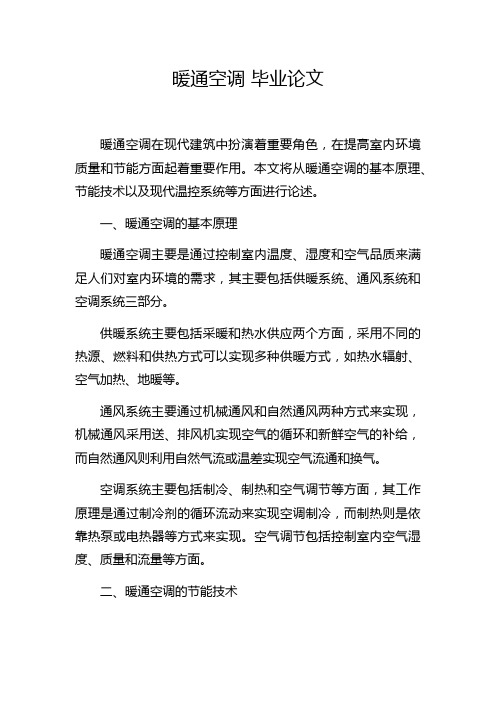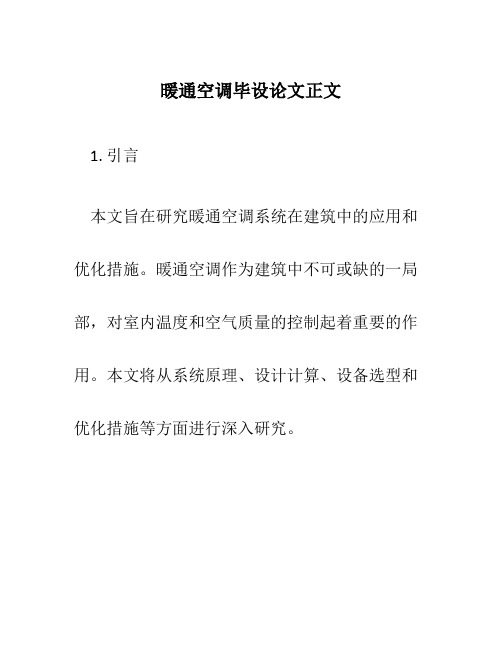暖通空调专业论文
暖通空调 毕业论文

暖通空调毕业论文暖通空调在现代建筑中扮演着重要角色,在提高室内环境质量和节能方面起着重要作用。
本文将从暖通空调的基本原理、节能技术以及现代温控系统等方面进行论述。
一、暖通空调的基本原理暖通空调主要是通过控制室内温度、湿度和空气品质来满足人们对室内环境的需求,其主要包括供暖系统、通风系统和空调系统三部分。
供暖系统主要包括采暖和热水供应两个方面,采用不同的热源、燃料和供热方式可以实现多种供暖方式,如热水辐射、空气加热、地暖等。
通风系统主要通过机械通风和自然通风两种方式来实现,机械通风采用送、排风机实现空气的循环和新鲜空气的补给,而自然通风则利用自然气流或温差实现空气流通和换气。
空调系统主要包括制冷、制热和空气调节等方面,其工作原理是通过制冷剂的循环流动来实现空调制冷,而制热则是依靠热泵或电热器等方式来实现。
空气调节包括控制室内空气湿度、质量和流量等方面。
二、暖通空调的节能技术暖通空调在实现舒适、健康的室内环境的同时,也消耗了大量的能源。
因此,节能技术的应用是提高暖通空调系统能效和降低能源消耗的关键。
1. 高效供暖采用高效、低耗的燃料和热源,如地源热泵、太阳能、燃气锅炉等。
2. 通风换气采用新型的通风换气方式,如温度和湿度控制、CO2浓度控制、热回收等技术,以降低能源消耗和排放。
3. 区域控制根据不同区域的不同需求,采用独立控制系统,实现室内温度、湿度和空气品质等的差异化调节,以提高能效。
4. 节能材料和技术采用节能建材和设计,如高效节能窗户、隔热墙体、优化日光利用等,以减少能量损失和提高系统效率。
三、现代温控系统的应用现代温控系统是暖通空调中的关键技术之一,其通过监测室内温度、湿度和空气品质等参数,自动调节供暖、通风和空调系统的运行,以实现目标温度、湿度和空气品质。
目前,市场上存在多种类型的温控系统,如传统的人工调节系统、数字智能温控系统和无人值守智能温控系统等。
数字智能温控系统在智能化程度方面更高,能够实现多种控制模式,并通过数据采集和处理来分析室内环境的变化趋势,优化供暖、通风和空调系统的运行,提高能效。
暖通空调毕设论文正文

暖通空调毕设论文正文1. 引言本文旨在研究暖通空调系统在建筑中的应用和优化措施。
暖通空调作为建筑中不可或缺的一局部,对室内温度和空气质量的控制起着重要的作用。
本文将从系统原理、设计计算、设备选型和优化措施等方面进行深入研究。
2. 系统原理暖通空调系统是建筑中对室内温度、湿度和空气质量进行调控的系统。
系统主要包括供热系统、供冷系统、通风系统和空气处理系统。
在本章中,将对这几个系统的原理进行介绍,包括各个子系统的工作原理和相互之间的关系。
3. 设计计算在设计暖通空调系统时,需要进行一系列的计算,以确定合理的设计参数。
本章将介绍暖通空调系统的设计计算方法,包括热负荷计算、风量计算和管道设计等。
通过合理的计算方法,可以有效地确定系统的尺寸和配套设备,从而提高系统的效能和能源利用率。
4. 设备选型在暖通空调系统中,设备选型是决定系统性能的关键因素之一。
本章将介绍常见的暖通空调设备,包括供热设备、供冷设备、风机和空气处理设备等。
对每种设备的特点和选型规那么进行详细介绍,帮助读者在实际工程中选择适合的设备。
5. 优化措施为了提高暖通空调系统的效能和能源利用率,可以采取一系列的优化措施。
本章将介绍常见的优化措施,包括系统控制策略、能源管理和新技术应用等。
这些措施可以使系统更加智能化和高效化,提供更舒适和节能的室内环境。
6. 实例分析通过实例分析,本章将对暖通空调系统的应用进行具体说明。
选取几个不同类型的建筑,包括住宅、商业办公和公共建筑等,对其暖通空调系统进行分析和评估。
通过实例分析,可以更好地理解系统设计和优化的实际应用。
7. 结论在本章中,对本文的研究内容进行总结和归纳。
通过对暖通空调系统的深入研究和实例分析,本文提出了一系列的设计和优化措施,以提高系统的效能和能源利用率。
同时也指出了一些需要进一步研究的问题,为后续的工作提供了一定的参考。
参考文献[1] 许XX. 暖通空调系统设计与分析[J]. 建筑技术开发,2024,45(2):15-20.[2] 张XX,王XX. 暖通空调节能技术研究[J]. 建筑节能,2024,36(4):55-60.[3] 李XX,赵XX. 暖通空调系统优化研究综述[J]. 建筑科学与工程,2024,57(6):10-15.以上是?暖通空调毕设论文正文?的大致框架,每个章节可以根据实际情况展开论述。
暖通空调论文

暖通空调论文
暖通空调是一种用于调节室内温度、湿度和空气质量的系统,它在现代建筑中起着重要的作用。
暖通空调系统可以提供舒适的室内环境,同时减少能源消耗和环境影响。
在本论文中,将探讨暖通空调系统的设计、运行和优化。
首先,本论文将介绍暖通空调系统的基本原理和组成部分。
暖通空调系统通常由供暖、通风和空调三个部分组成。
供暖部分负责提供室内热量,通风部分负责循环和净化室内空气,而空调部分负责控制室内温度和湿度。
然后,本论文将讨论暖通空调系统的设计原则和方法。
暖通空调系统的设计应考虑室内外温度差、房间容积、建筑材料和使用需求等因素。
通过合理布局和选用合适的设备,可以实现能源高效和舒适的室内环境。
接下来,本论文将探讨暖通空调系统的运行和管理。
通过监控和调节设备运行参数,可以实现节能和环保的运营。
此外,定期维护和清洁设备也是确保系统正常运行和延长使用寿命的重要措施。
最后,本论文将介绍暖通空调系统的优化方法和未来发展趋势。
通过采用先进的控制策略和技术,如智能控制系统和可再生能源利用,可以进一步提高暖通空调系统的能效和环境影响。
综上所述,暖通空调系统是一种重要的建筑设施,它可以提供
舒适的室内环境,并减少能源消耗和环境影响。
通过合理的设计、运行和优化,可以实现暖通空调系统的高效和可持续发展。
暖通空调毕业设计论文

暖通空调毕业设计论文暖通空调设计论文摘要:暖通空调系统在现代建筑中起着重要的作用。
本文介绍了暖通空调系统的设计原理和应用技术,并针对其中一建筑进行了暖通空调系统的设计。
通过系统的分析和计算,得出了合理的设计方案,并对系统的运行效果进行了评估。
关键词:暖通空调系统、设计原理、应用技术、设计方案、运行效果一、引言暖通空调系统是指以人为中心,为了改善人们在室内的热环境、湿环境和空气质量而进行的技术措施和工程设备的系统。
暖通空调系统在现代建筑中应用广泛,不仅可以提供舒适的室内环境,还可以实现节能减排的目标。
因此,对暖通空调系统进行科学的设计是十分重要的。
二、暖通空调系统的设计原理(一)热负荷计算热负荷计算是暖通空调系统设计的基础,主要包括计算室内热传递热负荷、室外热传递热负荷和风量热负荷。
根据建筑的建筑面积、墙体、窗户、楼顶、地面、人员活动和设备等因素,利用热传递计算公式和热负荷计算软件,得出室内外热负荷的数值,为暖通空调系统的容量确定提供参考依据。
(二)供热系统的设计供热系统是暖通空调系统中的重要组成部分,主要包括锅炉、循环水泵、换热器、水处理设备等。
供热系统的设计需要考虑到建筑的供热需求和能源利用效率。
根据热负荷计算的结果,确定供热系统的容量,并选择合适的设备以及管道布局,使其满足建筑的采暖需求。
(三)空调系统的设计空调系统主要包括送风系统和排风系统。
送风系统通过空调机组将处理过的新风送入室内,保持室内空气的新鲜和舒适;排风系统通过风机将室内污染的废气排出,提供良好的室内环境。
设计空调系统需要考虑到建筑的通风需求和舒适性要求,合理选择空调机组和风机,并进行合理的布局和管道设计。
三、暖通空调系统的应用技术(一)变频技术变频技术是目前暖通空调系统中广泛应用的技术之一,通过调整设备的运行频率,实现能源的节约和运行的灵活性。
利用变频技术可以根据室内的热负荷情况和人员的需求,调整空调机组的负荷和运行时间,提高系统的能效比。
暖通专业技术论文

暖通专业技术论文暖通专业在计算方法、程序编制和工程应用几方面都取得了显著成绩。
下面是由店铺整理的暖通专业技术论文,谢谢你的阅读。
暖通专业技术论文篇一暖通空调技术与节能摘要:随着人们生活水平的日益提高,人们生活的节奏逐渐加快及心理压力的不断增大,使得人们的工作生活环境应该予以重视。
而在人们的工作生活环境中倡导环保和节能的生活方式越来越重要。
本文主要是对暖通空调技术与节能进行分析。
关键词:暖通空调技术节能2009年9月22日,国家主席胡锦涛在联合国气候变化峰会开幕式上发表题为《携手应对气候变化挑战――在联合国气候变化峰会开幕式上的讲话》的重要讲话,郑重承诺今后中国将进一步把应对气候变化纳入经济社会发展规划,并继续采取强有力的措施:一是加强节能、提高能效工作;二是大力发展可再生能源和核能;三是大力增加森林碳汇;四是大力发展绿色经济,积极发展低碳经济和循环经济,研发和推广气候友好技术。
明确提出了建设生态文明的重大战略任务,强调要坚持节约资源和保护环境的基本国策,坚持走可持续发展道路,在加快建设资源节约型国家。
可见节能对于一个国家乃至世界时是多么的重要。
本文主要从节能方面浅谈暖通空调技术。
1.室内设计参数常规情况下,在冬季供暖时,室内计算温度每降低1℃,能耗将减少约5%~10%;在夏季供冷时,室内计算温度每升高1℃,能耗将减少约8%~10%。
室内设计参数必须在规定的参数范围内取值。
近几年,低温地板辐射采暖系统已经取代散热器采暖,之所以采用这种方式,主要是因为这种方式具有能耗小、舒适性高、容易分户计量、不占用房间使用面积等优点。
2.采暖设计采暖空调热负荷为12650KW,热指标为。
热源由城市热网供给,一次水供回水温度为95/70℃,经热交换后,高温二次水供回水温度为85/60℃,供采暖系统及空气、新风处理机组使用。
各类机房、自行车库等设5-8℃的值班采暖,人防掩蔽体采暖设计温度为18℃,厕所为16℃;低温二次水供回水温度为60/50℃,供风机盘管和汽车坡道化雪系统使用,或者化雪系统由于什么原因没有使用。
暖通空调节能研究论文

暖通空调节能研究论文随着经济的发展与科学技术的进步,空调已经不再是奢侈品,已经越来越普及化,不只是在办公楼、商场和豪华住宅里能看到,而且在很多居民区、酒店、学校等场所都已经普及使用。
但是,随着用电量的逐年增加,空调的节能使用已经成为了当下很多科学家的关注重点。
因此,在这篇文档中,我将探讨一个相关的研究——“暖通空调节能研究论文”。
一、研究背景和意义空调作为一种常见的生活用品,不仅给我们带来了舒适的使用环境,同时为国家造福,获得了良好的经济效益。
但是,空调的能源消耗过大,观念上的浪费以及相应的高额电费已经引起了国内外专家、学者和政策制定者的关注,因此众多专家学者不断的研究,寻求科学的方法来降低空调的能耗,减少环境污染,推动能源利用的可持续发展。
二、研究内容和方法在整个暖通空调节能研究过程中,主要是通过优化空调系统的系统设计、系统运行方式和控制设备,以减少能源消耗的原则提高空调系统的运行效率和压缩能源浪费。
常见的研究方法包括:实验模拟——在实验室或特殊场地开展虚拟环境下进行全面的控制和研究;实际测试——在实际生活环境中或针对某一类空调设备的真实情况进行测试和分析,用数据来验证结论。
同时,研究主要集中在优化各种技术手段的空调系统,包括太阳能、地源热泵、CO2、饱和空气机组等各种形式,探索不同空调系统的优缺点,并进一步通过实验和模拟寻找最优方案,共同达到节能的目的。
三、研究成果通过多次试验和实践,该论文在空调系统节能的方面取得了显著的成果。
市场上已经出现了许多符合节能标准要求的空调设备,能够满足人们的需求。
同时,政府和专家学者也开始付出更多的努力,加强对节能空调技术的推广与应用。
该论文所涉及的主要研究成果包括:1. 尽可能利用区域内自然条件的优势,如大量使用地源热泵、太阳能集热技术和地暖系统。
2. 使用节能型空调,如使用高效的空调芯片,逆变空调、变频空调等可以有效减少能耗的空调。
3. 通过控制系统优化及科学合理的管理措施,如在日常使用中控制室温度基本在28℃左右,最大限度降低温度差异,尽量避免空调出现运行浪费。
暖通空调毕业论文
暖通空调毕业论文暖通空调技术在现代社会中扮演着重要角色。
在建筑物的设计与施工中,暖通空调系统是必不可少的一环。
暖通空调系统不仅能保证室内的温度、湿度、空气质量,还能提高室内舒适度,提高人们的生活质量。
本文将从暖通空调系统的结构、设计原则、运行原理以及维护管理等方面进行分析和论述,希望能够对暖通空调技术有一定的了解和认识。
一、暖通空调系统的结构暖通空调系统主要由冷热源设备、空气处理设备、输送设备以及温控设备组成。
其中,冷热源设备包括空调机组、冷水机组等,空气处理设备包括送风机、新风机、排风机等,输送设备包括风管、水管等,温控设备包括温度传感器、温控器等。
二、暖通空调系统的设计原则设计暖通空调系统时需要考虑以下几个原则:1、合理性原则。
设计时应根据建筑物的用途、结构和环境条件,合理配置冷热源设备、空气处理设备、输送设备和温控设备,以达到使用效果的最佳化。
2、节能性原则。
在设计过程中应考虑节能措施,例如合理利用建筑物本身的自然条件,如采用地热、太阳能等新能源,或采用高效节能设备等,最大程度节约能源。
3、可靠性原则。
设计时应考虑设备和材料的可靠性和耐用性,以确保设备长期稳定运行,减少维修和更换次数。
4、安全性原则。
在设计运行过程中应考虑操作者和使用者的安全,设计时应注意机房的安全和通风等问题,保证安全和健康。
三、暖通空调系统的运行原理暖通空调系统的运行原理是以空气和水为媒介,将室内的热量、湿度、空气质量等进行调节。
具体可以分为以下几个步骤:1、冷热源设备加热或制冷的过程。
空调系统通过制冷剂或空气对冷热源设备进行制冷或加热。
2、空气处理的过程。
空气处理设备对室内空气进行处理,如加湿、除湿、过滤等,使空气质量得到控制。
3、空气输送的过程。
输送设备将经过空气处理的空气输送到各个房间,保证房间内的通风和换气。
4、温度控制的过程。
温控设备对室内的温度进行控制,确保室内温度的稳定和舒适。
四、暖通空调系统的维护管理维护管理是保证暖通空调系统正常运行和延长其使用寿命的重要环节。
供热通风空调技术论文
供热通风空调技术论文我国供热通风与空调等设备在各类建筑工程安装中也具有较大的施工量,而且在安装质量上也具有较高的要求。
下面小编给大家分享一些供热通风空调技术论文,大家快来跟小编一起欣赏吧。
供热通风空调技术论文篇一供热通风与空调安装技术探究【摘要】建筑行业凭借着先进的技术与设备而得到了显著的发展,作为建筑工程中重要基础设施的暖通空调设备,其安装技术也不断发展起来。
为了积极响应国家节能环保的政策方针,我们在对暖通空调设备安装之前必须要进行合理的设计,以实现节能环保的要求。
本文就供热通风与空调安装技术进行深入研究,对其中存在的问题进行探讨,并提出了相应的解决措施,以供相关技术人员参考。
【关键词】供热通风;空调安装;技术研究;关键环节0.引言近年来,我国经济水平与人们的生活水平都得到了显著的提高,对于建筑工程也提出了更高的要求。
为了使建筑工程的使用功能得到充分发挥,我们还需要在工程中设置多种基础设施。
暖通空调设备的主要功能是调节室内的温度与湿度,改善空气条件,作为工程中最重要的基础设施,其安装技术值得我们深入探讨,只有采用科学合理的安装技术,通过沟通与协作,严格按照设计图纸进行合理的安装,只有这样才能够保证其安装质量,达到节能环保的目的,满足人们对建筑工程的高要求,为人们创造一个安静、舒适的生活环境。
1.供热通风与空调安装中常见的质量问题1.1空调设备的定位及管线交叉的问题在现代化社会发展中,设计者在对暖通空调设备进行设计的过程中,往往会采用CAD软件设计图纸,并且在进行设计之前还需要进行勘测,明确设备的定位以及管线的交叉问题,然后通过科学合理的计算来保证其设计的合理性。
但是在实际工作中,由于设计者没有开展设计前的勘测工作或者勘测工作不够准确,计算方法不恰当等,这就会导致设备在安装过程中存在问题,管线交叉,使其在后期安装过程中受到多种因素的干扰,甚至在设备运行中产生较大的噪音或者振动,影响到人们的正常生活,也不利于设备的正常使用。
暖通空调科技论文
暖通空调科技论文暖通空调科技的比较和优选是一个涉及面广、影响因素多的复杂技术工作。
店铺为大家整理的暖通空调科技论文,希望你们喜欢。
暖通空调科技论文篇一暖通空调节能科技及设计的分析摘要:暖通空调行业的全新产品、新科学技术、新原料的发展及革新,在以后的建筑进步中发挥着非常关键性的影响作用。
为此,本文对暖通空调的节能科技有关问题进行简单的论述。
摘要:本文作者分析了暖通空调行业现实情况及急需改进的问题,介绍了暖通空调在节能方面的设计及应用。
关键词:暖通;空调;节能科技节能设计;分析中图分类号: TE08文献标识码:A 文章编号:一、暖通空调节能科技技术1、暖通空调系统能耗的构成及主要特点伴随着我们国家经济的迅速发展,能源及环境矛盾逐渐显现出来,城市化进程的不断深入及人们生活水准的提升,使得建筑能源损耗在总体能源损耗上占据的比重越来越多。
暖通空调系统的能耗还有几个特点,表现在:第一,系统的设计、选型、运行管理的不合理,将会降低能量使用效率。
第二,维持室内空气环境所需的冷热能量品位较低且有季节性。
这就使在具备条件的情况下有可能利用天然能源来满足要求,。
第三,暖通空调系统涉及到的冷热量的处理通常以交换形式处理,这就可以采用冷热回收的措施来减少系统的能耗,有效利用能量。
2 暖通空调的意义及其对人体的影响暖通空调可以满足室内的生活氛围,为人类的日常生活及工程提供最为舒服的环境,安装暖通空调变得非常重要。
如何有效地解决房内存在的空气问题,成为人们普遍关注的焦点。
安装暖通空调能将室内外的空气进行气流的交换,并提供大量的新鲜空气,改善室内的空气质量。
3 暖通空调系统的节能途径3.1 改善建筑保温性能。
对于暖通空调系统而言,通过维护结构的(冷热负荷)空调负荷占有很大比例,而维护结构的保温性能决定维护结构综合传热系数的大小,亦即决定通过维护结构的(冷热负荷)空调负荷的大小。
3.2 引进新型节能科技。
影响人体热舒适性的环境参数众多,不同的环境参数组合可以得到相同的热舒适性效果,但不同的热湿环境参数组合空调系统的能耗是不相同的。
暖通空调节能设计论文
暖通空调节能设计论文摘要:暖通空调系统作为一种提高人们居住舒适度的系统设备,在我国的很多地区都己经得到了广泛的普及与应用,但其耗能量大,污染环境的特点却也成为了当前暖通空调系统应用中最大的问题为了解决这一问题,真正实现节能环保、经济舒适的暖通空调系统,必须要大力开展节能环保技术在暖通空调系统中的应用于发展,进一步提高系统的节能环保性能。
前言社会不断进步,人们对物质文化的要求也在不断增加,与此同时,能源消耗巨大,而且很多能源都是不可循环再生能源,所以节约能源,增加能源利用率就成了现代研究的主要目标。
建筑产业一直是能源消耗巨大的产业,所以在现代建筑中多数要求设计者采取节能设计。
众所周知,暖通空调在工程设计中是能源消耗大户,建筑能耗比例可以看出,空调己经占据了整个建筑能耗的30~50%以上,作为建筑节能的支柱力量,我们应紧随国家政策,严格遵守节能规范,将节能措施贯于暖通空调的设计之中。
1建筑暖通空调系统的高耗能原因分析目前,我国的建筑暖通空调系统还存在高耗能的问题,在空调的调节系统设计上还存在很多不合理之处,冷机和风机以及水泵脱离了高效点运行的轨道,还不能实现能源利用的高效。
建筑暖通空调系统中的开关切换不及时,也会造成空调效能的浪费。
筑物的结构保温上,玻璃幕墙结构的采用上由于朝向和进深的设计存在很多不合理,这会造成空调系统的内外区冷热不均。
空调系统的外区一般受外界气象因素的影响比较大,在温度较高的季节就需要供冷,而在低温时则需要供热。
此外建筑暖通系统中的水量失衡情况也时有发生,冷冻水量的不足会致使冷冻水的温度偏高,这样就造成冷机的制冷处于低效状态,这种低效状态就不能有效供应那些水量不足的用户关于温湿度方面的需求,也会在很大程度上影响空调系统的节能效果。
2暖通空调系统在建筑工程设计中存在的问题暖通空调安装设计做为建筑工程的重要组成部分,其技术和安装工艺必须严格按照相应的规范和要求来实施,并通过相应的调试、试运行考核达到相应要求方可完成。
- 1、下载文档前请自行甄别文档内容的完整性,平台不提供额外的编辑、内容补充、找答案等附加服务。
- 2、"仅部分预览"的文档,不可在线预览部分如存在完整性等问题,可反馈申请退款(可完整预览的文档不适用该条件!)。
- 3、如文档侵犯您的权益,请联系客服反馈,我们会尽快为您处理(人工客服工作时间:9:00-18:30)。
暖通空调专业论文
暖通空调专业简介
我所学专业是建筑环境与设备工程。
一开始对此专业毫不了解,通过对各种专业课的学习,逐渐了解了该专业的主要研究领域。
本专业培养具备室内环境设备系统及建筑公共设施系统的设计、安装调试、运行管理及国民经济各部门所需的特殊环境的研究开发的基础理论知识及能力,能在设计研究院、建筑工程公司、物业管理公司及相关的科研、生产、教学等单位从事工作的高级工程技术人才。
主要课程有:工程热力学、传热学、流体力学、建筑环境学机械设计基础、自动控制原理、流体输配管网、热质交换原理与设备、建筑给排水工程、建筑电气、空调技术、制冷技术、供热工程、设备自动化、锅炉及锅炉房设备、工业通风、建筑设备自动化、建筑电气、高层民用建筑空调设计、燃气工程、建筑设备工程预算等。
其中暖通方向是发展较为完备并且十分重要的区域。
在北方,冬季需要供暖,涉及暖通。
暖通在学科分类中的全称为供热供燃气通风及空调工程,包括:采暖、通风、空气调节这三个方面,从功能上说是建筑的一个组成部分。
暖通的英文缩写HVAC(Heating,Ventilating and Air Conditioning)。
暖通空调是分户的中央空调,中央空调它最大特点,是能够创造一种舒适的室内环境。
而家居一般的分体的空调,它只能解决冷暖问题,而解决不了空气处理过程。
现在,有了暖通空调就不一样了。
现在这个空气处理过程它有以下这些过程:首先是空气进来以后,除了引进新风以外,可以把空气进行冷却处理,然后就进行过滤处理,过滤处理以后,增加了几大特点:第一就增加电子除尘器.,它主要可以捕捉非常小的颗粒的灰尘,一般来讲它可以捕捉一个微米的灰尘,而这个灰尘的范围
内大部分都是细菌、病毒、烟尘,或者是异味这样就都可以过滤掉;另外就是会增加一种加湿设备,这个加湿器可以创造我们房间的加湿达到40%左右的相对湿度,这样人会感到很舒适。
在我国的建筑行业,一直以建筑设计院牵头。
一个建筑项目确立之后,首先由某个建筑设计院进行总体设计。
建筑的总体设计包括许多分项,一般如下:建筑设计,结构设计,基础设计,电力(强、弱电)设计,给排水设计,暖通设计,配套园林绿化景观设计等等。
暖通设计(如果该项目需要)是指该项目中的所需要的空气调节系统简称空调系统。
一般空调系统包括制冷供暖系统,新风系统,排风(排油烟)系统等的综合设计。
所以说暖通从功能上说是建筑的一个组成部分。
从建筑设计来说,他是建筑设计的一个分项。
并不是单指空调。
需要说明的一点是:空调在一个建筑中可能是中央空调系统,也可能是中央空调与独立空调的混合系统,也可能全部是独立空调的系统。
一切根据建筑的功能以及投资者的意向和实际需要而定。
空调是用人为的方法处理室内空气的温度、湿度、洁净度和气流速度的系统。
可使某些场所获得具有一定温度、湿度和空气质量的空气,以满足使用者及生产过程的要求和改善劳动卫生和室内气候条件。
按空气处理设备的集中程度划分为以下几类:
一、集中空调系统。
所有空气处理设备(风机、过滤器、加热器、冷却器、加湿器、减湿器和制冷机组等)都集中在空调机房内,空气处理后,由风管送到各空调房里。
这种空调系统热源和冷源也是集中的。
它处理空气量大,运行可靠,便于管理和维修,但机房占地面积大。
二、半集中空调系统。
集中在空调机房的空气处理设备,仅处理一部分空
气,另外在分散的各空调房间内还有空气处理设备。
它们或对室内空气进行就地处理,或对来自集中处理设备的空气进行补充再处理。
诱导系统、风机盘管+新风系统就是这种半集中式空调系统的典型例子。
三、局部式空调系统。
此系统是将空气处理设备全部分散在空调房间内,因此局部式空调系统又称为分散式空调系统。
通常使用的各种空调器就属于此类。
空调器将室内空气处理设备、室内风机等与冷热源与制冷剂输出系统分别集中在一个箱体内。
分散式空调只向室内输送冷热载体,而风在房间内的风机盘管内进行处理。
按采用新风量的划分为:
一、直流式系统。
又称全新风空调系统。
空调器处理的空气为全新风,送到各房间进热湿交换后全部排放到室外,没有回风管。
这种系统卫生条件好,能耗大,经济性差,用于有有害气体产生的车间。
实验室等。
二、闭式系统。
空调系统处理的空气全部再循环,不补充新风的系统。
系统能耗小,卫生条件差,需要对空气中氧气再生和备有二氧化碳吸式装置。
如用于地下建筑及潜艇的空调等。
三、混合式系统。
空调器处理的空气由回风和新风混合而成。
它兼有直流式和闭式的优点,应用比较普遍,如宾馆、剧场等场所的空调系统。
正是由于我们专业的存在,并一直努力设计创新更多更好的设备以供调节改善人们的生活环境以及生活方式,提高人们的生活水平。
城镇建筑环境的供暖、通风、空调及制冷系统安装、调试及运行管理需要我们的存在,建筑电气的设计业需要我们的协助。
为了创造更好的生活舒适度,我们一直在奋斗着,努力发展我们的专业,进行更深入的研究,希望能创造出更美好的明天。
我也要努力学习跟多的专业知识,希望毕业后成为设备工程师,创造出更优越的生活环境。
